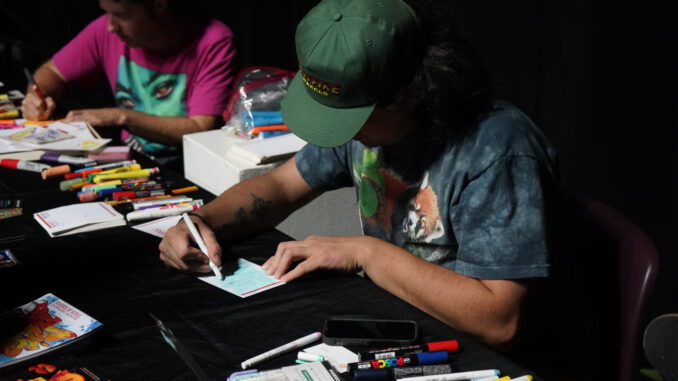
Zach Petroff & Ace Sevigny | Opinions Editor & Staff Writer
In her first solo exhibition in the United States, Akudzwe Elsie Chiwa wanted observers to come away with at least one perspective from her life’s work.
“Radical empathy,” Chiwa said. “People don’t know how to empathize with experiences that they have not had.”
The Zimbabwean contemporary artist was one of many creators highlighted at Friday’s Pittsburgh Cultural Trust Gallery Crawl in the Cultural District. From street magic to a race-based virtual reality experience, art enthusiasts had plenty of ways to emerge themselves in the different worlds of local artists’ creations.
The first designated stop on the art crawl took place at the Trust Arts education center on Liberty Avenue where First Lady of Pittsburgh Michelle Gainey hosted a paint pop-up that highlighted Black and student multimedia visual artists from across the city.
With DJ Femi setting the ambiance through her relevant hip-hop beats, art enthusiasts were fully immersed when exploring the creative work, such as seventh grader Hayal Anavata’s portrait of an elderly man based on her grandfather.
“Old people have a focus around them, but they never get respect,” Hayal said. “They have so much experience and are very wise, but no one really respects them. I wanted to bring the concept so people can recognize them and see that all people are valuable.”
The basement of the education center featured graffiti and mural artists. Among them were Shane Pilster and Max Gonzales, who were giving custom name tags created in street style.
“We have become full-time muralists, but absolutely our origins are in the traditions of graffiti,” Gonzales said.
“It’s important to us to help spread that art movement since it’s not very [popular] in Pittsburgh.”
Pilster and Gonzales along with DeVaughn Rogers were also showcasing a mural made by the students from the Art in the Garden and Rankin Christian Center summer camp.
“The project was made to unite the differing parts of Pittsburgh and allow creativity to join people together,” Rogers said.
During this summer camp, Rodgers and company taught students the basics of art, such as shading and lining.
In the end, the group created a 4 x 14 banner using the skills they learned, and even though the banner was cut in half to be displayed, the symbol of unity shined through.
From the Education Center, the cultural district turned into a playground of vast artistic capabilities.
The magicians of Liberty Magic performed playful tricks to passerby willing to watch or stop by the Arcade Comedy Club to catch a pop-up improv comedy show.
Duke alumna Chike Okwudiafor, an inspiring photographer and self-proclaimed lover of the arts, wanted to celebrate his birthday by enjoying the artistic work of local artists.
“I wanted to explore the art of the city,” Okwudiafor said. “I love Pittsburgh for that. I love supporting local creatives and supporting local business and stressing the use of art for personal changes.”
Chiwa’s presentation, “Divinity/Femininity,” was one of the more popular exhibits.
A provocative and thought-provoking gallery explored God from the lens of her own religion, Māori, a South-African religion that focuses on ancestors and the relationship with christianity.
Telling her story with 12 different displays representing 12 different women was the focal point of the work.
Using abstract painting, facade sculptures combined with authentic hair and shourds representing femininity in her culture, Chiwa captivated audiences with the deep messages that challenged conventional thinking around femininity and acceptance inspired by her connection with her ancestors.
“When I make these pieces,” Chiwa said, “I use the idea of intuition as my ancestral archive. I try to not have my hand or my idea, even though it’s still my work, but that’s the performative aspect of me making the work.”
Chiwa said she tries to imagine herself as her ancestors when choosing the narrative her art is trying to tell.
“I see it as releasing a story that is attached to an emotion.”
